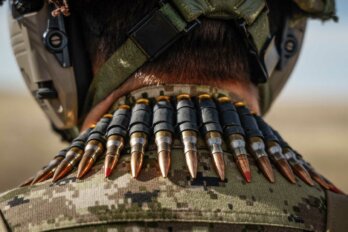In April 2009, an Ontario archaeologist sent a draft report to provincial officials, recommending that a large collection of Indigenous artifacts and human remains languishing in a Sudbury warehouse be stored in a climate-controlled facility to ensure proper preservation. The material, excavated over many years, came from Manitoulin Island in Lake Huron, as well as other sites across northern Ontario.
Government officials were preparing to ship the whole assemblage to Thunder Bay. But then, according to Sophie Corbiere, finance officer of the Ojibwe Cultural Foundation, an Anishinabek Nation elder heard about the planned move and asked the government to transfer the items to the OCF (located in M’Chigeeng First Nation, on Manitoulin Island) instead. In 2013, the OCF finally took possession of hundreds of boxes of remains and artifacts under a temporary repatriation arrangement, pending the identification of a permanent home. But when executive director Anong Migwans Beam inventoried the items, she discovered that 123 ceramic vessels or fragments thereof, many created by Anishinaabe artists living on the island, were missing—they’d been shipped to Western University in 2009 for academic study.
The episode reveals much about the messy state of Indigenous archaeological policy—a domain that has become more visible since the Truth and Reconciliation Commission released its final report in 2015. “The TRC is clear about Indigenous peoples managing their own heritage,” observes Alicia Hawkins, an archaeologist at Laurentian University. “[Archaeology] is part of that story.” But neither the current rules that cover archaeological artifacts and sites nor the resources presently available to support Indigenous collections in smaller communities
are adequate.
Because heritage falls under provincial jurisdiction, laws and regulations governing archaeology vary greatly across Canada. They also remain grounded in colonial assumptions about the ownership and treatment of artifacts. In Newfoundland and Labrador, archaeologists must transfer their findings to a public repository in St. John’s. In Quebec, the rules about stewardship and ownership vary depending on whether the artifacts were unearthed on private or Crown land. And in Ontario, archaeologists are legally obligated to protect whatever they excavate, but there are few rules about what happens next.
Generally, policy in Ontario simply doesn’t require private landowners to consult with local First Nations before beginning work on a site—which means they can assess properties without benefiting from the knowledge of local communities. “This is the absolute baseline and foundational deficiency in the system,” says Julie Kapyrka, a researcher who specializes in First Nations archaeology.
Some cases do follow a different trajectory, such as the extensive excavation of a 500-year-old cluster of ninety-eight Huron-Wendat longhouses found on a development site north of Toronto in 2002. More recently, a British Columbia property owner began building a large house on an island known to contain Coast Salish burial cairns. The project was technically compliant with provincial law (the design avoided the cairns), but faced with protests, the BC government expropriated the land, which is now being managed by a non-profit, in partnership with eight First Nations, with an eye to restoring the island’s cultural and ecological heritage.
Repatriation efforts across Canada are limited by the dearth of Indigenous-owned facilities with the necessary storage capacity, climate controls, and budget. “There is a great need for repositories on First Nations lands, in First Nations communities,” says Kapyrka, noting that nations aren’t allowed access to a government database of sites without signing a contract. “Why do First Nations need to enter into a contract to find out about where their own ancestral sites are?”
Toronto archaeologist Ron Williamson, an authority on southern Ontario Indigenous sites, says thousands of boxes of artifacts, mostly Huron-Wendat or from the Iroquoian Neutral Confederacy, languish in limbo. He cites an infamous case in which an archaeologist died suddenly and the boxes stored in his apartment were sent to a landfill.
As a profession, archaeologists are animated by the notion that artifacts tell stories that never make it into records such as census forms or tax rolls. Beam offers a specific example: a vessel recovered from the Manitoulin excavation provided a moment of validation for her father, the ceramic artist Carl Beam. “He was always convinced there was an Anishinaabe ceramic tradition,” she says. “But he was told there wasn’t.”
That story illustrates why archaeology has long had a tense relationship with Indigenous cultures. For generations, Indigenous artifacts were regarded as keepsakes to probe, experiment on, and sell. The collections found in modern museums were built on colonial plunder and later evolved to embrace a nineteenth-century scientific mandate that included the medical analysis of human remains.
Contemporary practitioners have sought to make the profession more collaborative, says Williamson, who has partnered with First Nations groups on numerous excavations. But Kapyrka says the regulations governing professional archaeologists in Ontario don’t require sufficient consultation with Indigenous groups. And Indigenous archaeological sites, she points out, account for the vast majority of excavations conducted across Canada.
Mounting pressure in the 1980s and 1990s from Indigenous groups in the United States and Australia led to rules mandating the repatriation of human remains in those countries. Canadian legislators never passed such laws. In 1999, the University of Toronto embarked on a fourteen-year process of repatriating the bones of more than 1,700 individuals in its possession. But until recently, such agreements tended to be the exception, not the norm.
In the meantime, the legal status of artifacts—which can serve as evidence in land claims negotiation—remains a long-standing sore point. “First Nations do not even have ownership rights over their own ancestors’ material culture,” says Kapyrka, pointing out that some artifacts are seen to be spiritually alive and deserving of an entirely different treatment.
In many cases, Indigenous artifacts also assert powerful cultural and emotional connections between past and present, countering the cultural obliteration inflicted by residential-school policies. Memorial University archaeologist Lisa Rankin has been working with officials and residents of Nunatsiavut, the self-governing Inuit region of northern Labrador, on digs in Hopedale, called Agvituk in Inuttitut. There, Rankin and a team of students and residents have excavated centuries-old settlements, finding tools, food remains, building materials, and a loonie-sized soapstone figurine of a man. She says the residents have been drawn to the project because it establishes a link to their past. “Excavating in houses where their great-great-grandparents may have lived gives them a connection to their history.”
The lack of local facilities, however, means they have to ship everything they find to The Rooms museum and archives in St. John’s, at least until Nunatsiavut opens its own repository or museum to house such items. As Rankin says, for the community “not having access to that stuff is a slap in the face.”
As many non-Indigenous Canadians take up Senator Murray Sinclair’s call for reconciliation and greater appreciation of Indigenous heritage, institutions including the Royal Ontario Museum and the Canadian Museum of History have bolstered their programming with everything from contemporary art to artifacts from archaeological sites.
Anong Migwans Beam finds herself at the other end of that equation, aware that huge quantities of Indigenous artifacts pour into these cultural powerhouses, which are cherry-picking the most interesting objects to put on display. Beam credits these institutions for reimagining their Indigenous collections, and mounting exhibitions such as the recent Anishinaabeg Art and Power at the ROM. However, Beam observes, “for the Anishinaabe, these objects have spirit and have an energy . . . It’s really helpful to have [them] shown closer to home, where a lot of people who are directly related to those objects and traditions can benefit from seeing them.





